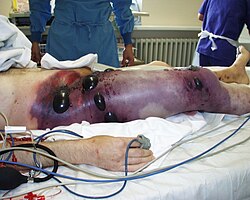Gas gangrene

Editor-In-Chief: Prab R Tumpati, MD
Obesity, Sleep & Internal medicine
Founder, WikiMD Wellnesspedia &
W8MD medical weight loss NYC and sleep center NYC
| Gas gangrene | |
|---|---|

| |
| Synonyms | Clostridial myonecrosis |
| Pronounce | N/A |
| Specialty | N/A |
| Symptoms | Severe pain, swelling, fever, skin discoloration, blisters with foul-smelling discharge |
| Complications | Sepsis, shock, organ failure |
| Onset | Rapid, within hours to days after injury |
| Duration | Variable, can be fatal within 48 hours if untreated |
| Types | N/A |
| Causes | Clostridium perfringens, Clostridium septicum, other Clostridium species |
| Risks | Trauma, surgery, diabetes mellitus, peripheral vascular disease |
| Diagnosis | Clinical diagnosis, imaging, Gram stain, culture |
| Differential diagnosis | Necrotizing fasciitis, cellulitis, deep vein thrombosis |
| Prevention | Proper wound care, prophylactic antibiotics in high-risk surgeries |
| Treatment | Surgical debridement, antibiotics, hyperbaric oxygen therapy |
| Medication | N/A |
| Prognosis | Poor if untreated; better with early intervention |
| Frequency | Rare |
| Deaths | N/A |
Gas gangrene is a bacterial infection that produces gas in tissues in gangrene. This deadly form of gangrene usually is caused by Clostridium perfringens bacteria. It is a medical emergency.
Causes[edit]
Gas gangrene is caused by a bacterial infection from the group of bacteria known as Clostridium. The bacteria produce gas and toxins, and are able to survive in conditions with low oxygen levels. The most common cause of gas gangrene is Clostridium perfringens, but other types of clostridium can also cause the condition.
Symptoms[edit]
The symptoms of gas gangrene include severe pain in the affected area, swelling, and the production of gas, which can be felt under the skin. The skin may become pale and then turn gray or purplish red. The patient may also experience fever, sweating, and increased heart rate.
Diagnosis[edit]
Gas gangrene is diagnosed through a physical examination and medical history. The doctor may also order imaging tests such as an X-ray or MRI to look for gas in the tissues. A sample of tissue or fluid may be taken from the affected area and tested for the presence of clostridium bacteria.
Treatment[edit]
Treatment for gas gangrene includes antibiotics to kill the bacteria and surgery to remove the dead tissue. In severe cases, amputation of the affected limb may be necessary. Hyperbaric oxygen therapy, which involves breathing pure oxygen in a pressurized room, may also be used to increase the amount of oxygen in the blood and help kill the bacteria.

Prevention[edit]
Prevention of gas gangrene involves proper wound care, especially for deep wounds and those caused by surgery or trauma. This includes cleaning the wound thoroughly and keeping it clean and dry.
Ad. Transform your life with W8MD's Budget GLP-1 injections from $75


W8MD offers a medical weight loss program to lose weight in Philadelphia. Our physician-supervised medical weight loss provides:
- Weight loss injections in NYC (generic and brand names):
- Zepbound / Mounjaro, Wegovy / Ozempic, Saxenda
- Most insurances accepted or discounted self-pay rates. We will obtain insurance prior authorizations if needed.
- Generic GLP1 weight loss injections from $75 for the starting dose.
- Also offer prescription weight loss medications including Phentermine, Qsymia, Diethylpropion, Contrave etc.
NYC weight loss doctor appointmentsNYC weight loss doctor appointments
Start your NYC weight loss journey today at our NYC medical weight loss and Philadelphia medical weight loss clinics.
- Call 718-946-5500 to lose weight in NYC or for medical weight loss in Philadelphia 215-676-2334.
- Tags:NYC medical weight loss, Philadelphia lose weight Zepbound NYC, Budget GLP1 weight loss injections, Wegovy Philadelphia, Wegovy NYC, Philadelphia medical weight loss, Brookly weight loss and Wegovy NYC
|
WikiMD's Wellness Encyclopedia |
| Let Food Be Thy Medicine Medicine Thy Food - Hippocrates |
Medical Disclaimer: WikiMD is not a substitute for professional medical advice. The information on WikiMD is provided as an information resource only, may be incorrect, outdated or misleading, and is not to be used or relied on for any diagnostic or treatment purposes. Please consult your health care provider before making any healthcare decisions or for guidance about a specific medical condition. WikiMD expressly disclaims responsibility, and shall have no liability, for any damages, loss, injury, or liability whatsoever suffered as a result of your reliance on the information contained in this site. By visiting this site you agree to the foregoing terms and conditions, which may from time to time be changed or supplemented by WikiMD. If you do not agree to the foregoing terms and conditions, you should not enter or use this site. See full disclaimer.
Credits:Most images are courtesy of Wikimedia commons, and templates, categories Wikipedia, licensed under CC BY SA or similar.
Translate this page: - East Asian
中文,
日本,
한국어,
South Asian
हिन्दी,
தமிழ்,
తెలుగు,
Urdu,
ಕನ್ನಡ,
Southeast Asian
Indonesian,
Vietnamese,
Thai,
မြန်မာဘာသာ,
বাংলা
European
español,
Deutsch,
français,
Greek,
português do Brasil,
polski,
română,
русский,
Nederlands,
norsk,
svenska,
suomi,
Italian
Middle Eastern & African
عربى,
Turkish,
Persian,
Hebrew,
Afrikaans,
isiZulu,
Kiswahili,
Other
Bulgarian,
Hungarian,
Czech,
Swedish,
മലയാളം,
मराठी,
ਪੰਜਾਬੀ,
ગુજરાતી,
Portuguese,
Ukrainian


